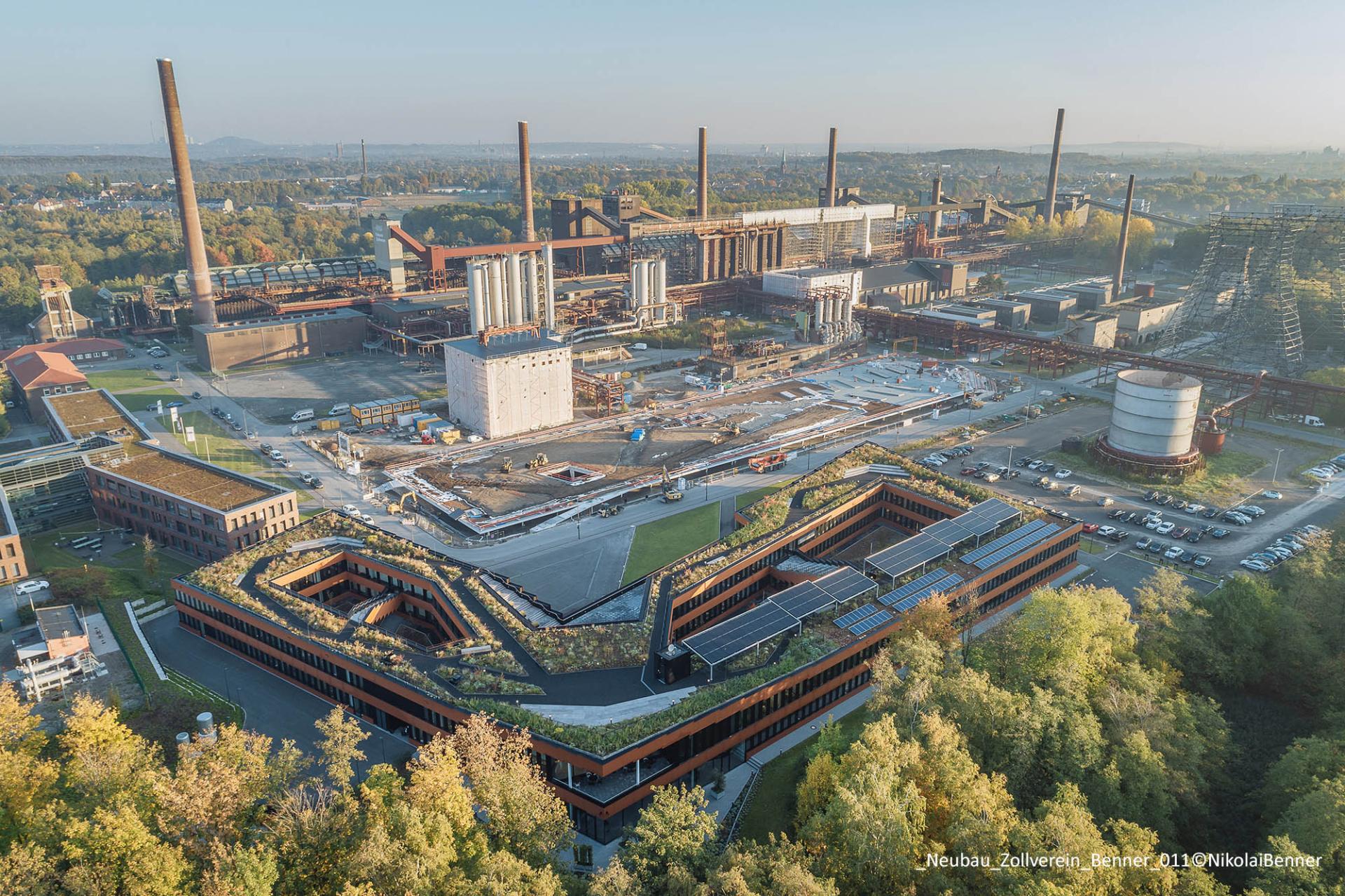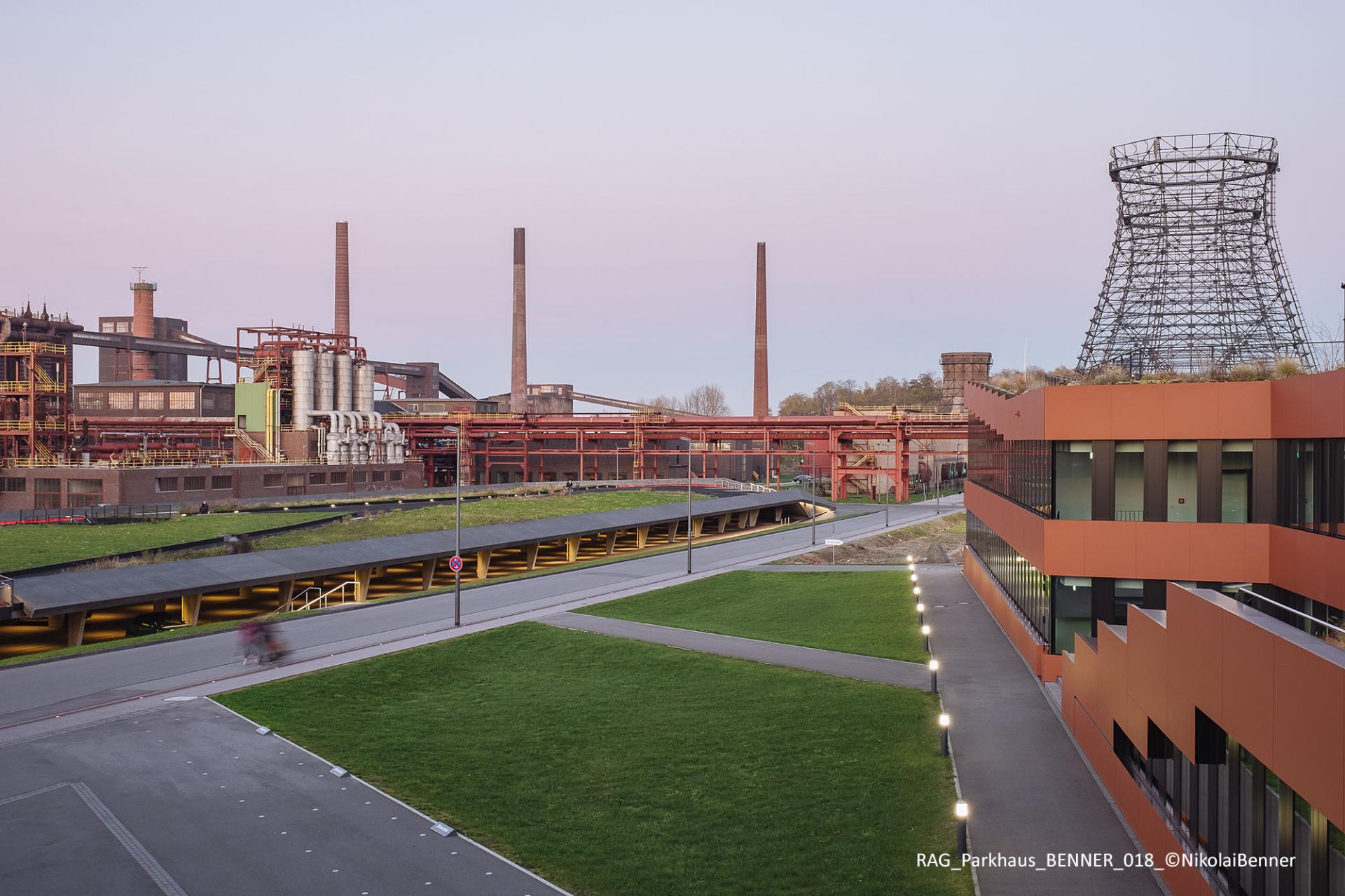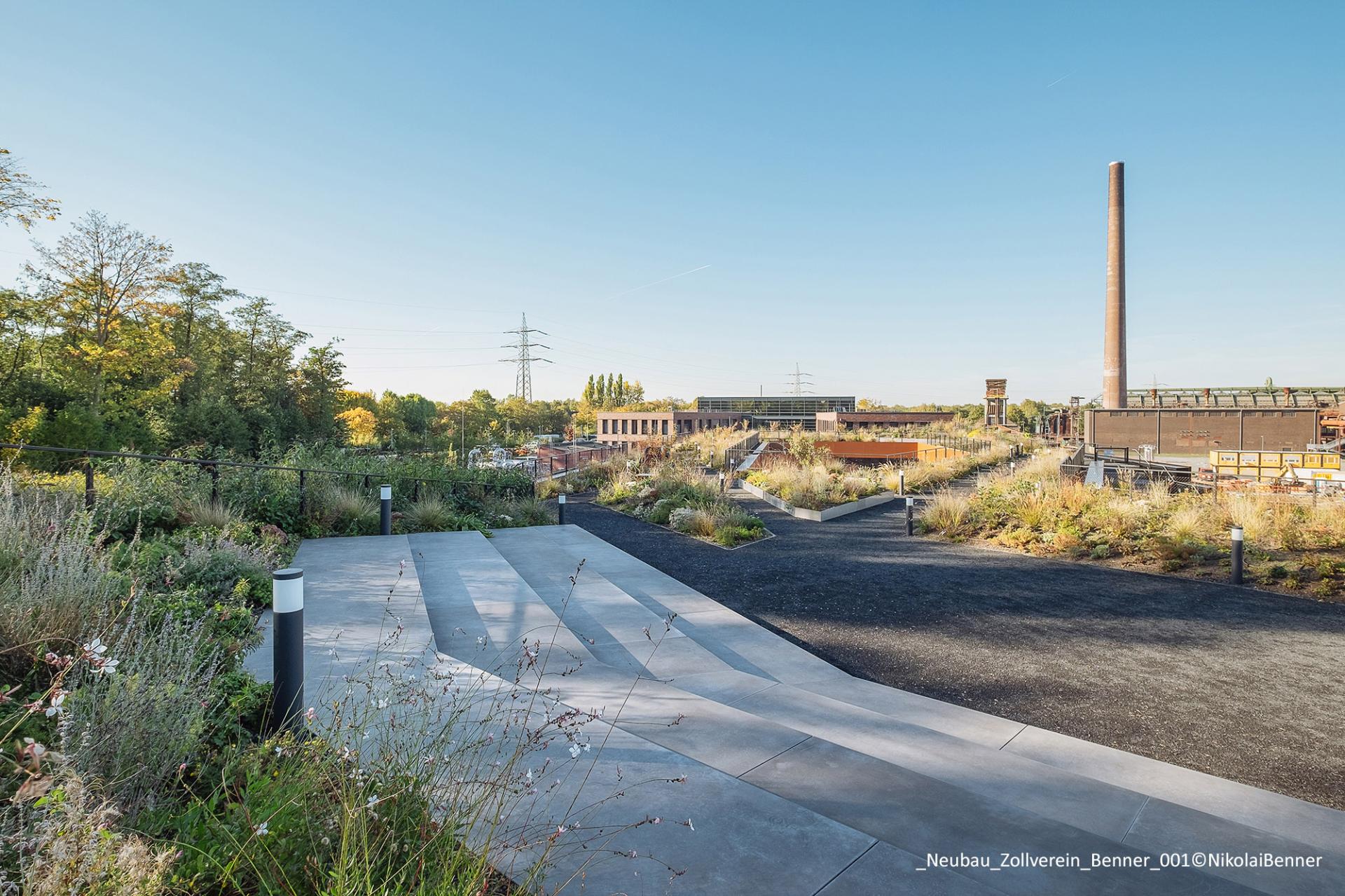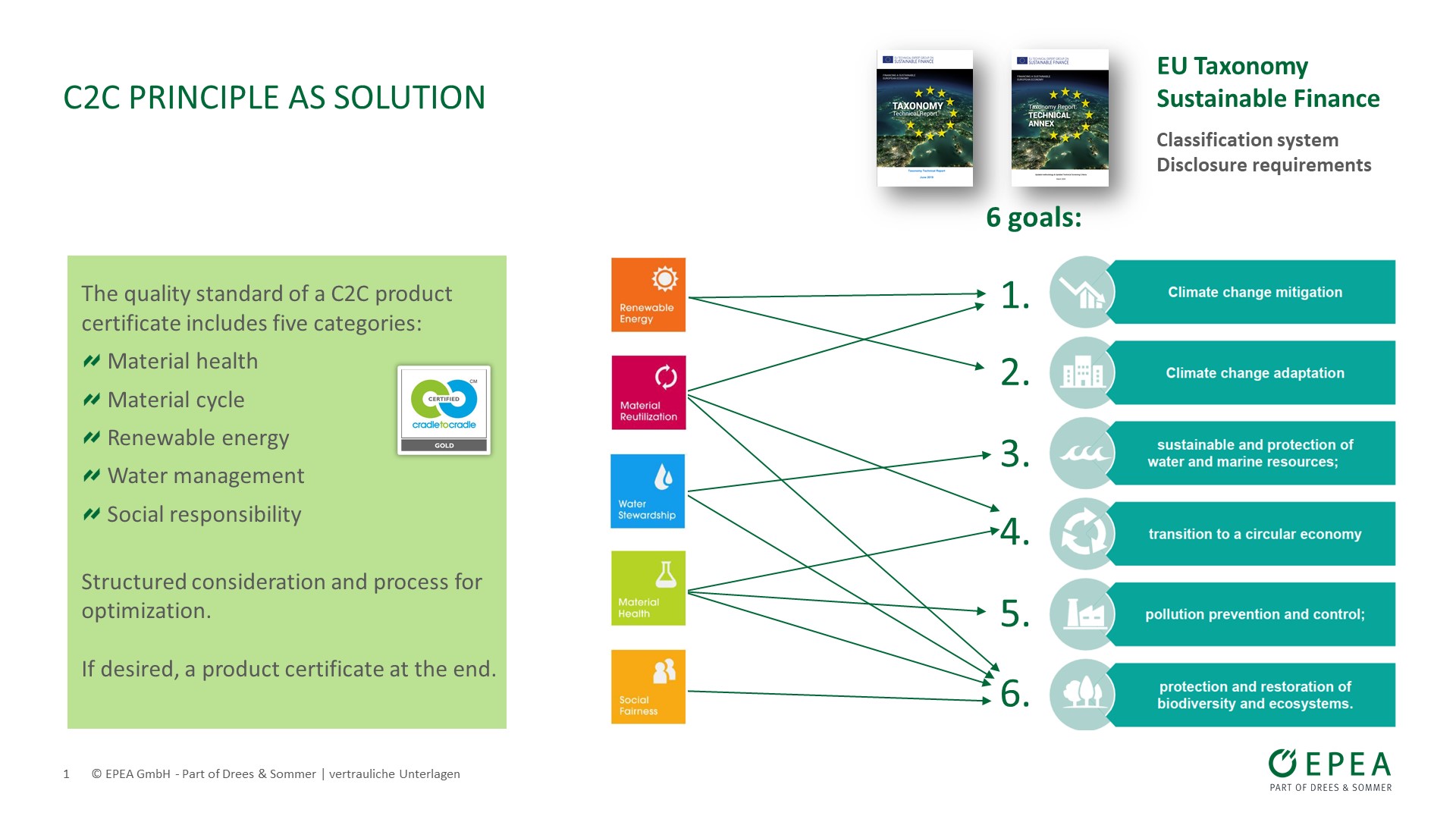Building as material bank
Basic information
Project Title
Full project title
Category
Project Description
The pilot project “New office building” is located in Essen, Germany, directly on the UNESCO world heritage site of “Zeche Zollverein”, a former coal mine industrial complex. The project is intended to be a pilot for renewable design with a special focus on the Cradle to Cradle design principles focusing on transformable and recyclable design, healthy materials and the use of a “Material Passports”. The multi-purpose roof landscape compensates for the ground area occupied by the development.
Project Region
EU Programme or fund
Description of the project
Summary
The new administrative headquarters of RAG Stiftung and RAG AG is located at the UNESCO World Heritage Site Zollverein in Essen. It is the first project in Germany that has implemented comprehensive measures inspired by the cradle-to-cradle principles (C2C) [see [(c2ccertified.org), ww. epea.com]; moreover, it has received a DGNB certificate with the highest Platinum rating. The accessible planted roof compensates for the building footprint and returns the covered area back to nature and mankind. The objective was to create an office building with highest sustainability standards which provides adequate space for the users and a structure that is embedded in the listed World Heritage complex in a sensitive way.The choice of the location on the originally industrial grounds of Zollverein means that priority was given to the recycling of the brownfield site of the former coal mine. On basis of the C2C-principles four added value ideas were defined for the building: 1. positive for human environment, 2. building as a power plant, 3. healthy + flexible working environment and 4. building as material bank. The closed-loop building generates energy, functions as a material bank and meets the highest requirements in terms of indoor air quality. The roof garden not only increases the biodiversity for flora and fauna and affects an improvement of the micro climate and air quality, it also functions as a space for the building occupants to linger, relax and communicate. Within the EU research project ‘Buildings as Material Banks’, the building was chosen as a pilot project and the materials used were documented in a material passport. This means that materials and components have not only been chosen for their health and environmental aspects but, more than anything else, for their circular economy strategies with the effect that the quality of raw materials is retained until the building reaches the end of its lifecycle and then functions as a resource bank
Key objectives for sustainability
Building material passport -> Material bank
Energy certificate -> Low CO2 emission, highest energy efficiency
Use of renewable energy: Geothermal plant and roof-mounted photovoltaic pergola
Charging station for electric cars and e-bikes
Water: Rainwater collection to water the planted roof and flush the toilets
Biodiversity: Green rooftop, urban gardening
Indoor health: Highest internal comfort, positive defined healthy materials based on Cradle to Cradle principles, VOC-testing in-situ
Cradle to Cradle certified materials: Aluminium profiles + glass panes, carpet tiles with dust-binding properties, glass partition wall system etc.
Green building certification with highest DGNB rating: Platinum
Key objectives for aesthetics and quality
Cradle to Cradle® is a design principle developed in the 1990s by Prof. Dr. Michael Braungart, William McDonough and EPEA Hamburg. It describes the safe and potentially infinite circulation of materials and nutrients in two cycles. In the biological cycle, consumables, such as natural fibers, circulate and can be safely returned into the cycle after use. In the technical cycle, consumer goods circulate, such as electronic items or floors and are being reused all over again. These products chosen are optimized in the design and manufacturing process as resources for the next phase of use. All ingredients are chemically harmless and recyclable according to Cradle to Cradle®.
The accessible planted roof landscape compensates for the area sealed by the development and offers a valuable space with an identity of its own at the intersection between the industrial cultural and natural landscape. The desire to give some of the nature back to the developed land has been achieved by creating an intensively planted roof. Mediating between the cultural and natural environments, the outcome is a green zone that in itself has become part of the landscape. Raised areas above the canteen and the corner rooms function as stepped seating areas; paths and terraces make the exterior space accessible. In between, a variety of shrubs, small bushes, a herb garden and a photovoltaic pergola as well as nest boxes for bats clearly refer to the issues of energy generation and use of natural resources. Consequently, the building offers its occupants high-quality exterior space and, at the same time, has a positive impact on the microclimate and biodiversity of the location.
This leads to a relevant improvement of the quality of stay in the building, an improvement of the users' health and a lower impact on the environment.
Key objectives for inclusion
The project “New office building” is located in Essen, Ruhr-area in Germany, directly on the UNESCO world heritage site of “Zeche Zollverein”, a former coal mine industrial complex, visited by over 1,5 million people per year. The demolition of pre-existing structures has already taken place before 2015 the project was set up, and the client has taken over the site as a prepared brown field. The new office building will host over 200 high quality office work places for the RAG Group. The total gross floor area will be approx. 10,000 m², with a total gross volume of approx. 39,000 m³. The project was intended to be a pilot for sustainable design of the next genation building with a special focus on the Cradle to Cradle design principles focusing on transformable and recyclable design, healthy materials and the use of a “Material Passports”. Also, parts of the building are planned to be accessible for public (e.g. the rooftop garden of approximately 3000 m²). Today's EU Taxonomy for sustainbale finance requests 6 main goals for 2050, all those goals can be already showed in this new office building. Why? Because the Cradle to Cradle® design principle in in line with the 6 goals of the EU Taxonomy.
Results in relation to category
Thermal building simulations and energy calculations have been used to improve renewable energy performance of the building in operation. In order to fulfill the holistic requirements this new sustainability approach including circularity was to find or develop a tool that enables a very detailed documentation of all the materials integrated in the building. This allows auditing the construction in terms of material health, environmental impact adaptability and recyclability, even during the planning and design process. At the same time, it provides all the information needed when the building shall be modified and adjusted to different purposes or finally deconstructed while generating a minimum amount of waste. Utilizing buildings as material banks and thus recycling them either completely or parts of them in high quality applications again and again is considerably simplified by compiling a comprehensive documentary of the components used in them during construction.
The “Building Material Passport” has been developed as a concept for a tool fulfilling all these requirements and subsequently was to be applied under the realistic background of a project development scenario on the German market. As it applies to this building, the “Materials Passport” refers not only individual construction products or building materials, but rather to the entire structure of the building at all levels. It can therefore be understood as a “Buildings’ Materials Passport” that covers the whole building which is greater than the maximum data depth for individual products.
How Citizens benefit
The rooftop garden of approximately 3000 m² is accessible for the public in agreement with the building owner. Other benefits include usage of regenerative sources of energy, improved indoor air quality and closed water cycle.
It is the first building project with C2C dedign principle in Germany and thus a starting example for the building industry, architects and cities to transfer this experience to own projects (like The Cradle in Düsseldorf, Cicular City in Munich, Moringa in Hamburg etc.). The results have been published HERE for everybody to see and use. Cradle to Cradle® dsign principles have been published HERE and HERE.
By implementing the material passport and recyclable design aspects within the project it will be possible to divert 4641 tons of waste from landfills, 91 tons of waste will not have to be disposed thermally and an additional 12108 tons of material can be recycled into products of equal quality.
Innovative character
First time a building is established according to circular design principles and construction and used a Building Material Passport as design and documentation tool.
A quality assurance process for the choice of materials was implemented that goes far beyond the legal standard for new buildings. Particular attention was paid to building products that are in direct contact with the interior. By using building products with low emission values and healthy content, a high quality of the interior air is guaranteed. Green walls and a dust-binding carpet ensure a pleasant indoor climate.
The multifunctional, extensive green roof creates a high-quality space for recreation and functions as a retention area for rainwater. For energy production and as a shading measure, pergolas equipped with PV modules were erected over the usable area and multiple charging stations for electric cars and e-bikes were built.
To ensure a conversion at the end of the building’s lifecycle, flexible and circular constructions were implemented in the design - instead of load-bearing interior walls, lightweight walls were installed.
In order to increase the separability and regeneration of the materials, adhesive bonding was largely replaced by mechanical connections. A carpet made of regenerative fibres and a C2C-certified parquet flooring were used as the floor covering. Both are part of a manufacturer's take-back system. All materials used are documented in a Material Passport that turns the building into a raw material depot for valuable materials.
The RAG building is DGNB Platinum certified. The principles of the Cradle to Cradle® design framework help to achieve better, sustainable performance.




